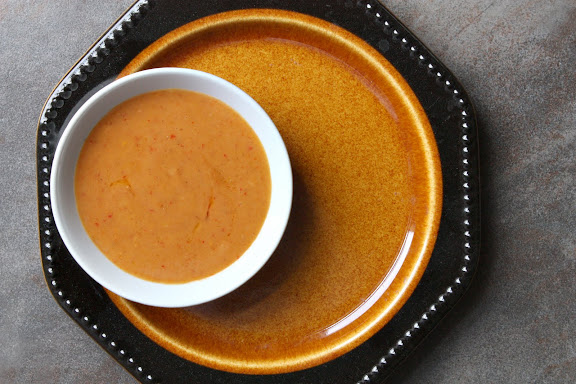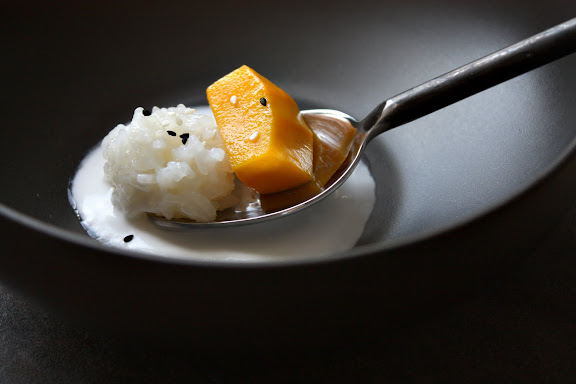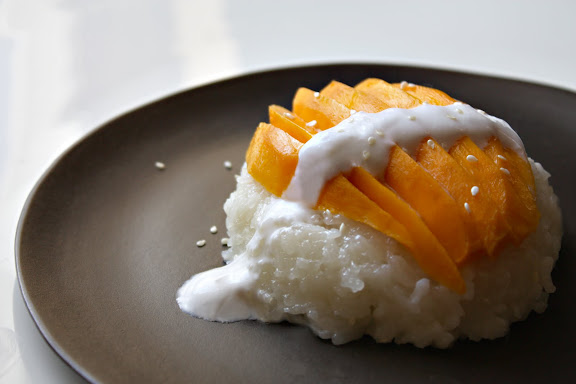
I hope I’m not insulting my own culture when I say that the number of Thai desserts which I don’t care for far exceeds the number of those I like. And among those I like is klip lamduan (unofficial: kleeb lamduan), old-school Thai cookies that I’ve long labeled “Thai shortbread cookies” even though, as far as I know, nobody else referred to them as such. Well, that’s exactly what they are. Continue Reading →
Archive | She Thais RSS feed for this section
Klip Lamduan: Thai Shortbread Cookies ขนมกลีบลำดวน
Easy Thai Peanut Sauce Recipe: How to Make My Mom’s Thai Satay Sauce

My mother, in whose memory this site was created, was a cookbook addict. Her philosophy in life was based upon a statement attributed to Erasmus of Rotterdam (1466-1536): When I get a little money I buy books, and if any is left I buy food and clothes. Replace “books” with “cookbooks” and you’ll get my mother.
Over the years, she had passed on several of her cookbooks to me for fear that years of living in the United States would result in me abandoning the cuisine of my original country or, worse, becoming so culinarily syncretic that I can’t tell how a dish is supposed to taste. Well, Mom is no longer with us, so she and I can’t have our once never-ending discussion on her view on culinary syncretism.
How I miss debating with Mom. Heck, I miss hearing her voice, period.
Thai Coconut Sticky Rice and Mango ข้าวเหนียวมะม่วง

At a risk of causing some raised eyebrows, I am going to say this: if you can produce excellent sweet coconut sticky rice and pair it with a perfectly ripe mango of exceptional quality, the kingdom of heaven is at hand; but if you’re going to fail — even just a little — on one component, may it be the sticky rice.
In fact, the coconut sticky rice is made to complement the mango, not the other way around. The rest of the year, this sweet coconut sticky rice is routinely made as a foil for different kinds of sweet and half-sweet-half-savory toppings. However, during the months of April through June when mangoes are at their best in Thailand, the same coconut sticky rice, which usually borders on being taken for granted, all of a sudden shows up all over town with big smiles that cannot be wiped off its sticky face now that it’s paired with mangoes at their peak.
It takes some practice to get the sticky rice part right, but when you pair it with the best mango, any shortcomings easily fade away. Tart, unripe, fibrous, tasteless mango, on the other hand, can ruin even the best quality coconut sticky rice.
- ½ cup raw Thai sticky rice (no substitute), soaked anywhere from one to 5 hours, drained, and rinsed to get rid of excess starch
- ½ cup good coconut milk
- ½ cup sugar
- ¼ teaspoon salt
- One perfectly ripe good mango (preferably Ataulfo), peeled and cut into thick slices
- Put the rice in a heatproof bowl and steam in a steamer, over medium heat, for about 20 minutes (based on one half cup of rice). The rice should be cooked through with no hard, raw bits in the middle of the grains. You can also cook the sticky rice without a steamer, using the splatter guard method.
- Turn off the heat and let the rice stay in the steamer, with the lid on, while you prepare the coconut milk.
- In a heatproof bowl, heat the coconut milk, sugar, and salt in the microwave on high for 2 minutes. The sugar should completely dissolve and the mixture should be very hot.
- Take the sticky rice out of the steamer. Pour the hot coconut mixture on top of the rice and gently stir. (It may look like your rice is drowned in coconut water, but the liquid will all be absorbed.) Cover the bowl tightly with plastic wrap and let the mixture stand at room temperature, undisturbed, for half an hour.
- The coconut sticky rice is to be served at room temperature along with fresh mango. The sesame seeds are optional.
- The rice can be refrigerated and reheated in the microwave, but the texture of reheated sticky rice isn’t as good as it is when freshly made. Freezing sticky rice is not recommended.
 Added June 26th, 2011: I made a batch of the sweet coconut sticky rice with palm sugar several days ago, because I ran out of white sugar. This is not what is normally done in Thailand, and I’d never done it this way before. You need to increase the amount of the sugar a little as palm sugar is not as sweet as white sugar (replace 1/2 cup white sugar in the recipe with 3/4 cup (packed) shaved palm sugar), and eventually — as you can see in the image above — you end up with beige-colored sweet sticky rice which some may consider not as appetizing. But, oh, my goodness, is this good.
Added June 26th, 2011: I made a batch of the sweet coconut sticky rice with palm sugar several days ago, because I ran out of white sugar. This is not what is normally done in Thailand, and I’d never done it this way before. You need to increase the amount of the sugar a little as palm sugar is not as sweet as white sugar (replace 1/2 cup white sugar in the recipe with 3/4 cup (packed) shaved palm sugar), and eventually — as you can see in the image above — you end up with beige-colored sweet sticky rice which some may consider not as appetizing. But, oh, my goodness, is this good.
 Added April 16th, 2012: This is a more streamlined, quicker, done-on-the-stovetop clone of Thai sticky rice and mango. Jasmine rice is used in place of the usual sticky rice and cooked in a pot, creating a result that bears more resemblance to western-style rice pudding than the classic Thai dessert. The flavor is the same, though. Pandan creates a more dramatic color contrast and provides the familiar scent of Southeast Asian treats, but you don’t need it. Visit my weekly column on Serious Eats for the recipe: Thai-Inspired Coconut-Pandan Rice Pudding and Mango.
Added April 16th, 2012: This is a more streamlined, quicker, done-on-the-stovetop clone of Thai sticky rice and mango. Jasmine rice is used in place of the usual sticky rice and cooked in a pot, creating a result that bears more resemblance to western-style rice pudding than the classic Thai dessert. The flavor is the same, though. Pandan creates a more dramatic color contrast and provides the familiar scent of Southeast Asian treats, but you don’t need it. Visit my weekly column on Serious Eats for the recipe: Thai-Inspired Coconut-Pandan Rice Pudding and Mango.
Related Posts:
Just What Is Thai Sticky Rice?
Chaokoh: My Favorite Brand of Coconut Milk
Choose the Right Mangoes for Your Thai Mango Coconut Sticky Rice
How to Peel and Slice a Ripe Mango
Enter your email to subscribe:
ARCHIVES
-
 Subscribe to The Epestle to Receive New Posts
June 30, 2021
Subscribe to The Epestle to Receive New Posts
June 30, 2021
-
 Introducing THE EPESTLE
February 13, 2021
Introducing THE EPESTLE
February 13, 2021
-
 Bury Me in Nam Phrik: Mike Sula’s Exploration of Thai Relishes (Plus Salted Soybean-Pork Rind Relish Recipe)
May 1, 2018
Bury Me in Nam Phrik: Mike Sula’s Exploration of Thai Relishes (Plus Salted Soybean-Pork Rind Relish Recipe)
May 1, 2018
-
 Food and Cooking in Thai TV Dramas, Love Destiny, 17th Century Siam, and Crispy Noodle-Wrapped Pork Dumplings
April 2, 2018
Food and Cooking in Thai TV Dramas, Love Destiny, 17th Century Siam, and Crispy Noodle-Wrapped Pork Dumplings
April 2, 2018
-
 A Simple Thai Dipping Sauce
March 12, 2018
A Simple Thai Dipping Sauce
March 12, 2018
-
 Northern Thai Rice Noodle Soup with Pork Ribs, Dried Cotton Flowers, and Tomatoes (Khanom Jin Nam Ngiao)
September 1, 2017
Northern Thai Rice Noodle Soup with Pork Ribs, Dried Cotton Flowers, and Tomatoes (Khanom Jin Nam Ngiao)
September 1, 2017
-
 How to Prepare Rice Vermicelli (Khanom Jin) from Dried Noodles
August 29, 2017
How to Prepare Rice Vermicelli (Khanom Jin) from Dried Noodles
August 29, 2017
-
 How to Prepare Pomelos for Thai Pomelo Salad
May 23, 2017
How to Prepare Pomelos for Thai Pomelo Salad
May 23, 2017











